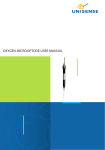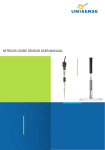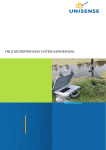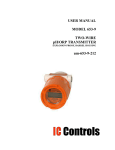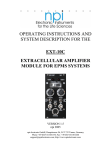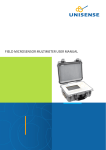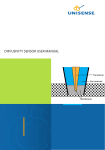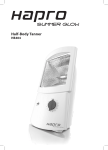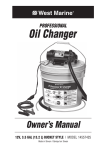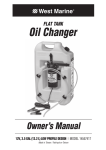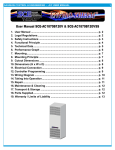Download REDOX AND REFERENCE ELECTRODE USER MANUAL
Transcript
REDOX AND REFERENCE ELECTRODE USER MANUAL 3 Redox and reference electrode manual Copyright © 2012 · Unisense A/S Version October 2012 REDOX AND REFERENCE ELECTRODE MANUAL UNISENSE A/S TABLE OF CONTENTS WARRANTY AND LIABILITY . . . . . . . . . . . . . . . . . . . . . . . . . . . . . . . . . . . . . . . . . . . . . . . . . . . 8 CONGRATULATIONS WITH YOUR NEW PRODUCT! . . . . . . . . . . . . . . . . . . . . . . . . . . . . 9 Support, ordering, and contact information 9 OVERVIEW . . . . . . . . . . . . . . . . . . . . . . . . . . . . . . . . . . . . . . . . . . . . . . . . . . . . . . . . . . . . . . . . . . . 11 Redox electrode Reference electrode 11 11 GETTING STARTED . . . . . . . . . . . . . . . . . . . . . . . . . . . . . . . . . . . . . . . . . . . . . . . . . . . . . . . . . . 12 MEASUREMENTS . . . . . . . . . . . . . . . . . . . . . . . . . . . . . . . . . . . . . . . . . . . . . . . . . . . . . . . . . . . . 16 Mounting of the electrode 16 ADVANCED REDOX ELECTRODES . . . . . . . . . . . . . . . . . . . . . . . . . . . . . . . . . . . . . . . . . . . . 17 STORAGE AND MAINTENANCE . . . . . . . . . . . . . . . . . . . . . . . . . . . . . . . . . . . . . . . . . . . . . . 18 Storage Cleaning the electrode 18 18 REFERENCES . . . . . . . . . . . . . . . . . . . . . . . . . . . . . . . . . . . . . . . . . . . . . . . . . . . . . . . . . . . . . . . . . 19 TROUBLE SHOOTING . . . . . . . . . . . . . . . . . . . . . . . . . . . . . . . . . . . . . . . . . . . . . . . . . . . . . . . 20 MANUAL FOR REF-RM . . . . . . . . . . . . . . . . . . . . . . . . . . . . . . . . . . . . . . . . . . . . . . . . . . . . . . . 21 WARRANTY AND LIABILITY CONGRATULATIONS WITH YOUR NEW PRODUCT! Notice to Purchaser Support, ordering, and contact information This product is for research use only. Not for use in human diagnostic or therapeutic procedures. The Unisense Redox electrode is a miniaturized platinum electrode that facilitates reliable and fast measurements with a high spatial resolution designed for research applications. Warning Microsensors have very pointed tips and must be handled with care to avoid personal injury and only by trained personnel. Unisense A/S recommends users to attend instruction courses to ensure proper use of the products. Warranty and Liability The Redox electrode is covered by a 90 days limited warranty. Microsensors are a consumable. Unisense will only replace dysfunctional sensors if they have been tested according with the instructions in the manual within 14 days of receipt of the sensor(s). The warranty does not include repair or replacement necessitated by accident, neglect, misuse, unauthorized repair, or modification of the product. In no event will Unisense A/S be liable for any direct, indirect, consequential or incidental damages, including lost profits, or for any claim by any third party, arising out of the use, the results of use, or the inability to use this product. If you wish to order additional products or if you encounter any problems and need scientific/technical assistance, please do not hesitate to contact our sales and support team. We will respond to your inquiry within one working day. E-mail: [email protected] Unisense A/S Tueager 1 DK-8200 Aarhus N, Denmark Tel: +45 8944 9500 Fax: +45 8944 9549 Further documentation and support is available at our website www.unisense.com. Unisense mechanical and electronic laboratory instruments must only be used under normal laboratory conditions in a dry and clean environment. Unisense assumes no liability for damages on laboratory instruments due to unintended field use or exposure to dust, humidity or corrosive environments. Repair or Adjustment Sensors and electrodes cannot be repaired. Equipment that is not covered by the warranty will, if possible, be repaired by Unisense A/S with appropriate charges paid by the customer. In case of return of equipment please contact us for return authorization. For further information please see the document General Terms of Sale and Delivery of Unisense A/S as well as the manuals for the respective products. 8 REPLACEMENT OF SENSORS Unisense will replace sensors that have been damaged during shipment provided that: • The sensors were tested immediately upon receipt in accordance with the delivery note and the manual • The seal is still intact. • The sensors are returned to Unisense for inspection within two weeks. • The sensors are correctly packed for return to Unisense, in accordance with the note included in the sensor box. 9 RECOMMENDED METERS FOR REDOX SENSORS One-channel meter: pH/mV-Meter Multi-channel meters for pH/redox: Microsensor Multimeter OVERVIEW Redox electrode The Unisense redox microelectrode is a miniaturized platinum electrode designed for research applications within physiology, biotechnology, environmental sciences, and related areas. With tip diameters down to around 10 microns, the Unisense redox microelectrode allows measurements of redox potential with a very high spatial resolution. The redox microelectrode can be used for measurements in salinities from 0 to full ocean strength. IMPORTANT Unisense sensors are neither intended nor approved for use on humans Measuring principle When the electrode tip is immersed in an aqueous solution and connected via a high-impedance millivolt-meter to a reference electrode (figure 1 and 2) immersed in the same solution, the Redox electrode tip will develop an electric potential relative to the reference electrode which reflects the tendency of the solution to release or take up electrons; also called the Oxidation-Reduction Potential (ORP). Thus, the redox microelectrode must be used in combination with a reference electrode (e.g. Unisense REF-RM) and connected to a high-impedance millivolt-meter. Reference electrode The Unisense reference electrode is a simple open-ended Ag-AgCl electrode with a gel-stabilized electrolyte. The reference electrode is used to establish a reference potential against the redox microelectrode. For laboratory use, Unisense provides a macro reference electrode from Radiometer Analytical (please see separate manual in the back of this booklet). Our micro-sized reference electrodes are glass electrodes manufactured at Unisense. For in situ use, Unisense manufactures a pressure-compensated macro electrode. 11 Connecting the electrodes GETTING STARTED Unpacking a new redox electrode. 1. When receiving a new microelectrode, remove the shock-absorbing grey plastic net. Unpacking a new reference electrode Radiometer Ref-RM 1. Remove the protection cap from the electrode and any seals covering the filling hole. WARNING Do not remove the seal and protective plastic tube before the following steps (1-4) are successfully completed. Connect the Unisense redox microelectrode to the amplifier. Connect the reference electrode to the black box on the redox electrode cable (banana plug connection). Immerse the redox electrode (still in its protective tube) in a buffer 7 solution. Place the tip of a reference electrode in the same solution. A Unisense redox electrode with internal reference has to be submerged sufficiently (2-3 cm) in the medium to cover the liquid junction during all measurements. IMPORTANT As the redox microelectrode is sensitive to temperature, it is necessary to perform calibration and subsequently measurements at the same temperature. In the following, we assume that you are using Unisense pH/ mV-Meter. If you are using another meter, perform analogous steps with the mV-meter in question. 2. Before starting a measurement, remove the clip which closes the electrode filling hole. Remember to replace the clip at the Calibration end of measurements. The redox potential (reduction potential) of a sample is measured in mV (V) or Eh, where 1 Eh = 1 mV. For all practical purposes is it impossible to measure the absolute potential and thus redox potentials are always given as a value relative to the standard hydrogen electrode (SHE). 3. Check the level of the filling solution. It should be approximately 0.5 cm below the filling hole. If necessary refill the KCl-Ag 3M KCl solution, saturated with AgCl. Unisense Reference electrode 1. When receiving a new electrode remove the shock-absorbing grey plastic net. 2. Remove the lower piece of tape and the rubber stopper in order to empty the tube of storage liquid. This liquid can be saved for future storage. In practice, the reference electrodes available do not have the same potential as the SHE. Therefore, before all redox measurements, it is important to measure the offset of the reference electrode that one is using relative to the standard hydrogen electrode. This is easily done with the recommended quinhydrone redox buffers and Unisense software. Quinhydrone is a mixture of equal amounts (molar basis) of hydrochinone and quinone. 3. The tip of the Unisense reference electrode (not the Ref-RM) should be kept immersed in water or an aqueous solution at all times, but can tolerate up to 10 minutes of exposure to air. IMPORTANT As redox electrodes directly reflects the potential to be measured, the calibration is linear and in principle only 1 point calibration is needed However, 2 points should be measured to ascertain valid electrode function. Response time is up to 10 seconds 12 13 The buffers have a defined redox potential, relative to the SHE electrode and thus these buffers can be used to calibrate the Unisense redox electrode with use of another reference electrode than the SHE electrode (compensating the measurements with an offset). into the pH 4 buffer. The signal is shown in “signal”. In “Value (Redox pot. (mV))” you manually enter the correct value from the table above (e.g. 470 at 20oC). Press add point when the signal is stable (look at the “time series measurements”). Redox potential of buffers: Temperature(oC) pH 4 buffer pH 7 buffer 20 470 295 25 462 285 30 454 275 Do the following 1. Connect the pH/mV-Meter to your 6. Now move the electrodes to the pH 7 buffer and do the same, entering the value from the table above (e.g. 295 at 20oC). Press add point. You now have the correct calibration. 7. Press Apply calibration and the calibration is shown in the table below the graph. 8. Then you tick the box “Calibrated” in the computer and start your SensorTrace lower part of the window. The electrode program. If you use a strip chart recorder signals are now shown as calibrated values or other data acquisition device, connect and the electrodes are ready for use. this to the output connections of the pH/ mV-Meter. 2. Prepare quinhydrone redox buffer If the sensor functions according to the above description, carefully remove the seal and the protective plastic tube before making measurements. solutions: Mix 100 ml of pH 4 buffer solution with 1 g of quinhydrone. Do the same with a pH 7 buffer solutions. Crystals of quinhydrone should be present indicating that the solution is saturated. 3. Expose both the reference electrode and the redox microelectrode tips to both quinhydrone redox buffers (pH 4 and 7). With use of Unisense software do the following: 4. Start SensorTrace BASIC or PRO with a new experiment, choose the redox sensor. Press Start. 5. The calibration tab is now shown. Put the redox electrode and the reference electrode 14 15 MEASUREMENTS Mounting of the electrode Although the Unisense Redox microelectrode is made of glass, the tip is flexible and can bend slightly around physical obstacles. However, large obstacles like stones or coarse lateral movements of the electrode when the tip is in contact with a solid substrate may cause the tip to break. Also, due to the small size of the microelectrode tip and to the steepness of redox gradients in many environments, even a displacement of the electrode tip of few microns may change its immediate redox environment. Therefore measurements should be performed only in a stabilized set-up fixed free of moving or vibrating devices. We recommend the Unisense lab stand LS18 and the Unisense micromanipulator MM-33 (MM33-2 or MMS) for laboratory use. For in-situ use we recommend our in situ stand (IS19) and a micromanipulator. ADVANCED REDOX ELECTRODES IMPORTANT Construction of the electrode with an internal reference involves the creation of a liquid junction approximately 3 cm from the electrode tip. During measurements this liquid junction has to be submersed in the medium in order to complete the measurement circuit.. Unisense can construct redox electrodes for customer requested applications at additional costs. The most frequently construction options are described at our web page under redox electrode specifications http://www.unisense.com/support/rd_spec.html The options include for instance customer specified dimensions, pressure tolerance, internal reference and cable length. If your specifications for a special redox electrode are not described at our web page please contact [email protected] for further options and prices. Electrical noise The electrical current generated by the high-impedance microelectrode is very small. Although the Unisense redox microelectrodes are very resistant to electrical noise from the environment, electrical fields may interfere with the electrode signal. Therefore we recommend that unnecessary electrical/ mechanical equipment is switched off and electrode or wires are not touched during operation. 16 17 STORAGE AND MAINTENANCE REFERENCES Storage • Kühl, M., Revsbech, N. P. 2001. Redox electrode Store the electrode in the protective plastic tube used for shipping. The room in which the redox microelectrode is stored should be dry and not too hot (10-30°C). Reference electrode Store in the protective glass tube used for shipping. For short-term storage (<10 min) the electrodes can be stored in air. For long-term storage the electrode tip must be immersed in 1M KCl in the protective casing used for shipping. The room in which the electrodes are stored should be dry and not too hot (10-25°C). Biogeochemical microsensors for boundary layer studies. In: The Benthic boundary layer, Boubreau, B. P, Jørgensen, B. B. (eds.). New York, Oxford University Press. pp 180-210. • Revsbech, N. P., and B. B. Jørgensen. 1986. Micro electrodes: Their Use in Microbial Ecology, p. 293-352. In K. C. Marshall (ed.), Advances in Microbial Ecology, vol. 9. Plenum, New York. Micro-reference electrode Store in the protective glass tube used for shipping. For short-term storage (<10 min) the electrodes can be stored in air. For long-term storage the electrode tip must be immersed in 1M KCl in the protective casing used for shipping. The room in which the electrodes are stored should be dry and not too hot (10-25°C). Cleaning the electrode The redox electrode can by cleaned by immersing it in nitric acid (1:1 H2O) Keep the electrode in the nitric acid solution for about 30 minutes and allow it to cool and rinse with water afterwards. The Ref-RM electrode should be rinsed with distilled water after measurements. Check the level of filling solution often. In case of deposits, please consult the separate manual in the back of this manual. The micro reference electrodes can be cleaned by flushing or submergence in 70% ethanol for a couple of minutes. After this, rinse with 1M KCl. 18 19 TROUBLE SHOOTING Problem Drift in the calibration potential values Possible cause Contamination of the platinum surface Solution Clean the electrode tip as described above Problem Sensitivity of the redox microelectrode is low or the signal is unstable. Contamination of the platinum surface. Possible cause 1 Solution Possible cause 2 Solution MANUAL FOR REF-RM Clean the electrode tip as described above. The reference electrode is malfunctioning. Repair or change the reference electrode. If you encounter other problems and need scientific/technical assistance, please contact [email protected] for on-line support (we will answer you within one workday) 20 21 22 23 UNISENSE, DENMARK www.unisense.com · [email protected]















